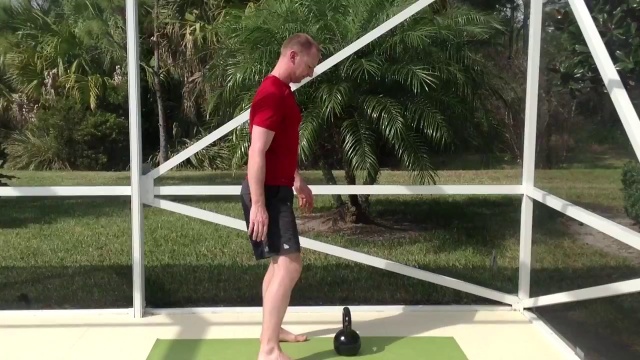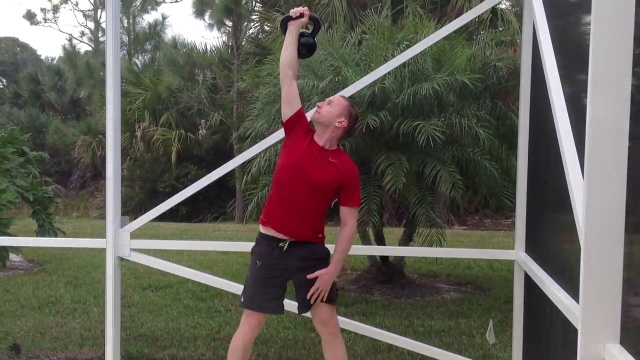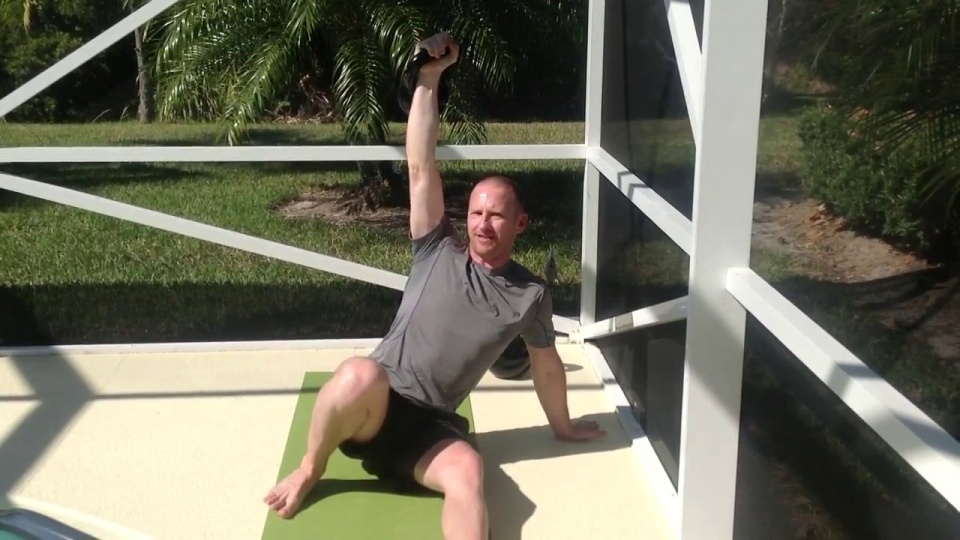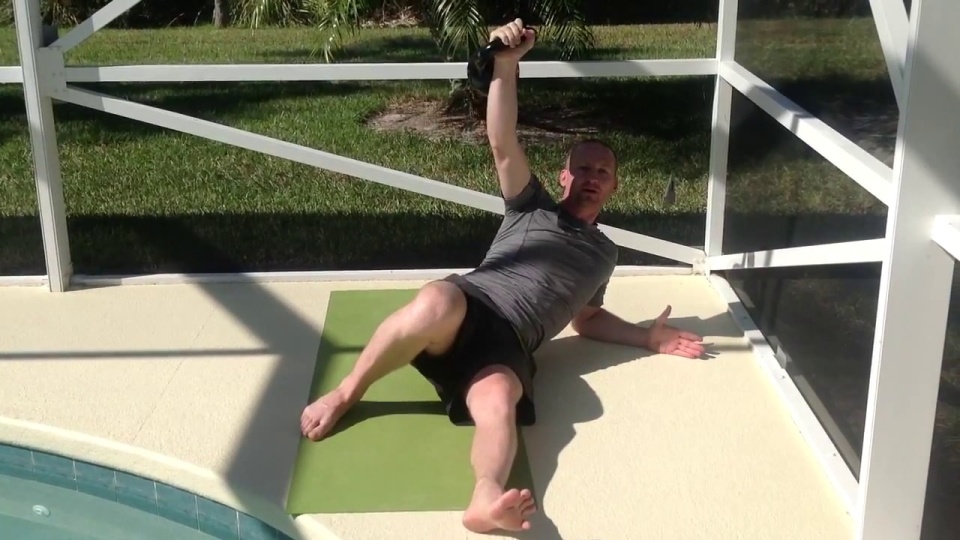BY GREG BROOKES
Why the Turkish Get Up is Important
Along with the Kettlebell Swing the TGU delivers huge results. The Turkish Get Up is very different from the Swing in that it focuses on your small stabilising muscles and develops a solid movement foundation.
During human development we earn our right to progress onto more demanding movements. Babies learn to roll before they can crawl, and crawl before they can walk.
In today’s society of quick fixes we are all too impatient and don’t want to earn our movement skills anymore. Beginners often advance too quickly and end up injuring themselves.
The Turkish Get Up will not let you progress too quickly. It will stop you in your tracks. If you have a weak core, poor mobility or weak stabilising muscles then you won’t be able to complete the movement.
OK, it’s time to see what you are made of and to earn your right to move like an athlete.
Quick video of the Turkish Get Up:
8 Benefits of the Kettlebell Turkish Get Up
1– Shoulder protection & rehabilitation
The shoulder joint is a very vulnerable area of the body, it has to be both mobile and strong. In order to keep the shoulder stable and in the correct position it has small stabilising muscles. The small stabilising muscles are often neglected in favour of the larger better looking prime mover muscles called the deltoids.
The Turkish Get Up helps develop the small stabilising muscles ensuring that the larger shoulder muscle have a solid platform to work from. Failure to develop the shoulders in the correct order of stabilisers first and larger prime movers second is one of the most common reasons for shoulder injury.
2 – Develop a functional core
Each hip joint is connected to the opposite shoulder via a muscular sling systemthat crosses the body. The Turkish Get Up develops this cross body sling system and so naturally improves your rotational strength for racket sports, running and more.
3 – Safeguard against back pain
The Turkish Get Up is great for mobilising the hips and upper back. Flexibility in the hips and upper back ensures that the lower back does not have to rotate excessively protecting it against potential back issues.
The added core conditioning that you receive from the Turkish Get Up also ensure that the lower back is better stabilised during movement.
4 – Improve posture
As you progress through the Turkish Get Up you realise that alignment is very important. In fact, completing the Turkish Get Up without good body alignment is very difficult. If your posture is not as good as it should be the Get Up will certainly highlight that and put your body into a better position.
5 – Full body integration
There are not many muscles that are left out when you perform the Turkish Get Up. The real beauty of this exercise is that every muscle has to work with each other in order to complete the full movement.
The Get Up is complex. It requires constant cross overs between the left and right side. Stabilising muscles have to hold tight as larger prime mover muscles work in sync with them. Joints must also be supple enough to put the body in the correct alignment throughout the movement.
6– Assessment tool
We all have movement issues whether it is lacking adequate movement through the joints, weak core muscles, dominate large prime mover muscles, poor balance, or bad proprioception.
The Turkish Get Up will quickly highlight your problems and help you to overcome them. I frequently use the Turkish Get Up as an assessment tool with clients to see an instant snapshot of their current movement skills.
7 – Improve overhead confidence and strength
During the Turkish Get Up the kettlebell is constantly overhead. Developing stabilising strength and confidence through this movement will dramatically boost confidencefor other kettlebell exercises like the Snatch.
As mentioned strong shoulder stabilising muscles are vital for shoulder health. Spending time developing the stabilising muscles through the Get Up will provide a much healthier and stronger platform for your larger shoulder muscles. If you struggle to press heavy weights overhead then this is the exercise for you.
8 – Warm Up
Due to the huge amount of muscle engagement and mobility required to perform the Turkish Get Up this exercise works well as a warm up. A few Turkish Get Ups before each workout will prepare you nicely and also give you a quick snapshot of your daily health.
If you find the Get Up warm up particularly difficult one day then you may want to reduce the amount of intended exercise for that workout.
7 Steps of the Kettlebell Turkish Get Up
1– Arm Extension
From the Fetal position roll onto your back and help the kettlebell into the straight arm position. Don’t take your eyes off the kettlebell. Rotate your arm until it sits nicely in the shoulder joint. Use the opposite hand to adjust the kettlebell position so it lays comfortably against the back of the forearm.

Common Mistakes:
- Bent wrist – keep the wrist straight, do not let it cock backwards
- Shoulder not down in its socket – pull the shoulder down and into the floor
- Arm not locked out – you’re stronger when your arm is locked out, straighten it
- Bad arm alignment – make sure that the arm is at 90 degrees to the floor
2 – Knee Bend
Bend the leg on the same side as the kettlebell and place the opposite arm out at 45 degrees. Ensure the sole of the foot is in contact with the floor.

Common Mistakes:
- Foot position – keep the foot at hip width, not too wide or too narrow
- Shallow bend – ensure you bend the knee adequately enough so you are not limited in the sit up
3 – Sit Up
Squeeze the handle tight as you sit up along the line of your arm, first to elbow and then to hand. Keep the kettlebell arm down with the shoulder in its socket and the opposite shoulder away from the ear.

Common Mistakes:
- Side rolling sit up – don’t roll to the side in order to sit up, sit up at an angle following the line of your arm
- Standard sit up – don’t sit up straight towards your hips, sit up at an angle following the line of your arm
- Relying on the arm – try to avoid overloading the arm as you sit up, as you get stronger you should barely use the arm
- Jerking sit up – stay smooth as you sit up, don’t rock up and use momentum
- Using the kettlebell – don’t lean the kettlebell forward to help pull you up
- Raising the heel – keep your outstretched heel on the floor, failure to do so means you are overusing your hip flexors
- Keep shoulder down – keep the kettlebell shoulder deep in its socket
- Collapsing the chest – lift the ribcage and open up the chest, important for posture
- Sinking bottom shoulder – create distance between the bottom shoulder and the ear
Assessment Indicators:
Failure to sit up smoothly without jerking or using the kettlebell will indicate a weakness in the core muscles. Practice the Single Leg Deadlift as well as this part of the movement without a kettlebell.
Problems sitting up tall without keeping the bottom leg straight could indicate tightness in the hamstrings. Work on hamstring flexibility if necessary.
4– Hip Extension
Push from the heel of the bent leg and drive your hips in the air and into full hip extension. There should be a straight line from the kettlebell to the bottom hand. Create distance between the bottom shoulder and the ear and open up the chest. Squeeze the glutes tight.

Common Mistakes:
- Not fully extending the hips – push the hips up and squeeze the glutes tight
- Raising the bottom heel – extension should come from the hips not the toes, keep the heel down
- Arching lower back – don’t extend from the lower back push up through the hips, squeezing the glutes will help
- Sinking bottom shoulder – keep the shoulder and ear as far apart as possible
- Disconnecting upper shoulder – keep the top shoulder down and deep in its socket
- Bad arm alignment – if there is not a straight line from the kettlebell to bottom hand you will find the weight very heavy
Assessment Indicators:
Failure to correctly extend the hips could be due to tightness through the hip flexors or quad (rectus femoris) if so mobilise and stretch them.
Failure to extend through the hips but through the lower back could be weak glutes. Practice Bridges and Single Leg Deadlifts.
5 – Sweep
Sweep the straight leg back and through to a half kneeling position. Try to bring the leg straight through rather than around in a semi circular movement. Keep your eyes focused on the kettlebell at all times. You will notice some nice rotational mobility here.

Common Mistakes:
- Don’t combine with step 6 – ensure you define this step without moving too quickly onto the next one
- Not opening the hips – take the knee back as far back as possible, don’t cramp yourself up, create space
- Lifting front heel – keep the heel down as you pull the leg through
- Bad shoulders – as with earlier steps keep the bottom shoulder away from your ear and top packed down
- Moving hand – keep the hand planted, it should not need to move, only sweep the leg
Assessment Indictors:
With this movement we are looking at the hips. Tight hips will prevent the sweep coming back through smoothly. Hip flexor stretches and hip openers will help improve the movement if necessary.
6 – Half Kneeling
Taking the hand off the floor straighten the body by folding sideway at the waist. Take the eyes off the kettlebell and look forwards.

Common Mistakes:
- Arching the lower back – keep the glutes tight and hips forwards
- Not folding sideways – pull yourself sideways hinging at the waist. Do not rotate into the upright position
- Standing straight up – ensure you perform this step before standing up or you miss an important core exercise
- Caving at the chest – look forwards and pull the ribcage up
- Folding forwards at the hips – push the hips through with glutes tight, do not crease forwards and collapse the hips
Assessment Indicators:
Failure to fold at the waist and straighten sideways could be a core weakness. Practice the movement perfectly without a kettlebell to improve your strength.
Having difficulty kneeling tall with the hips through and chest raised could be tight hip flexors and/or weak glutes and/or weak core stabilisers.
7 – Standing
Drive from the front heel and stand. Steady yourself and then reverse the movement, step by step.

Common Mistakes:
- Not pulling from the heel – don’t push from the rear leg to stand, pull yourself up from the front
- Forward leaning – often if your stance is too narrow then standing looks ugly, improve on your Sweep (step 5)
- Floating shoulder – keep that kettlebell shoulder deep into its socket as you stand
- Bending arm – stay strong and keep that top arm locked out
Assessment Indicators:
Fundamentally you are performing an overhead lunge from the bottom position during this movement. If you find this movement tricky then practice your deep lunges without a kettlebell and also the overhead warm up exercise.
The Turkish Get Up Decent
As you reverse the movement take your time. You are basically performing the movement backwards. There is one exception with the decent, you do not perform the hip extension as shown in step 4.
A Full Kettlebell Turkish Get Up should take at least 30 seconds to complete.
Once you reach step 2 you can either sit back up again and repeat the movementor you can take the kettlebell back to step 1 and to the floor. Beginners should certainly practice returning the kettlebell back to the floor and then changing arms and repeating.
Practicing and Progressing the Turkish Get Up
As you can see the Turkish Get Up is quite a complex movement but when you break it down it becomes a lot more manageable.
Here is how I suggest you practice and develop the movement:
Step 1 – Half Naked
As with all exercise, you should only load the body when you can perform the movement without a weight. Start by practicing the Turkish Get Up from steps 1 – 3. You will finish at the the Sit up position and then return slowly back to step 1 again.
Practice on both sides until the movements from step 1 to 3 are very smooth. You will be getting a great core workout if you take your time and perform the movements correctly.
When you can perform 10 repetitions smoothly on each side move onto step 2 below.
Step 2 – Full Naked
Once you have mastered the half get up progress onto the full get up still without using a kettlebell. Keep the whole movement slow and controlled.
Practice the full movement holding a cup of water. When you can complete the Turkish Get Up without spilling any water, move onto the next step below.
Step 3 – Half Loaded
Similar to step 1 but this time you are going to use a kettlebell. You can start with whatever weight you feel comfortable with but usually Men start with a 12kg / 25lbskettlebell and Women use an 8kg / 15lbs.
Watch my Half Turkish Get Up Tutorial:
If you find all this is too much then go back to the Naked variations above until you are ready.
When you can perform 5 smooth repetitions on each side without putting the kettlebell down in between reps move onto the Full Get Up below.
Step 4 – Full Loaded
Now you’re ready for the big time, the complete Turkish Get Up with a kettlebell. Perform just 1 repetition at a time and then put the kettlebell down and change sides.
Watch my Full Turkish Get Up Tutorial:
When to increase the kettlebell weight?
You will probably have a good feeling as to when it is time to increase the weight.
As a guide I usually find that when a client can perform 5 repetitions smoothly on both sides without unlocking the arm then it is time to start introducing the next weight.
6 Turkish Get Up Variations
1– Reverse Get Up
The Reverse Get Up is much more practical than the Regular Get Up because it starts and finishes from the standing position. I like to use this Get Up variation with my clients and during my kettlebell classes because it is easier to flow from a standing exercise straight into the Get Up.
Watch my Reverse Turkish Get Up Tutorial:
2– Alternating Swings
Once you have mastered the Reverse Turkish Get Up you can then add exercises at the top of the movement between each Get Up repetition.
Using alternating swings is a great way to not only add some cardio into the movement but also change hands and give the arms a rest.

Workout Drill:
- Reverse Turkish Get Up Left x 1
- Alternating Swings x 10
- Reverse Turkish Get Up Right x 1
3– Windmill
Just as we added the alternating swings at the top of the movement you can also add the Windmill at the top too.
Using the windmill will add extra attention to the stabilising muscles of the shoulder but also work more into the hamstring flexibility and core muscles.
Ensure that you are strong at the Full Get Up before attempting this because your shoulders will have to work harder and for longer before getting a break.

Workout Drill:
- Reverse Turkish Get Up Left x 1
- Windmill x 5
- Reverse Turkish Get Up Left x 1
4– Snatch
If you really want to spice up your Get Ups then adding a Snatch at the top of the movement will certainly do the job.
The kettlebell snatch is a full body cardiovascular exercise that will allow a few seconds for your shoulder to rest between Get Up repetitions.

Workout Drill:
- Full Turkish Get Up Left x 1
- Snatch x 10
- Change sides or repeat
5 – Side Plank
I’m not usually one for making exercises overly complicated but I do like this advanced version of the Get Up.
When you get to step 4 of the Get Up stack one foot on top of the other as if performing a side plank. You will be performing a side plank on one hand and have a kettlebll in the other so balance and alignment is important.
Practice this variation without a kettlebell before trying it out loaded.
6 – Two Hands
Take your kettlebell Turkish Get Up to the next level by using 2 kettlebells one in each hand. The movement is slightly different because you sit up with both legs out in front of you and then swing one leg behind and underneath you in order to stand up.
Try this variation without kettlebells first to see just how much hip mobility and core strength you need.
Kettlebell Turkish Get Up Workouts
1– Ladder
For beginners I like to start with the Turkish Get Up ladder. The ladder workout moves through every step of the Get Up so it ensures that no part of the process is missed out.
You will find that by practicing this workout you will quickly identify the areas of the Get Up that require further attention.
Here’s how it works:
- Step 2 to Step 3 – 1 rep
- Return to Step 2
- Step 2 to Step 4 – 1 rep
- Return to Step 2
- Step 2 to Step 5 – 1 rep
- Return to Step 2
- Step 2 to Step 6 – 1 rep
- Return to Step 2
- Step 2 to Step 7 – 1 rep
- Return to Step 2
Basically you are adding an extra step to the movement each round until you complete the full Turkish Get Up. Remember, the arm should never unlock and you should not put the kettlebell down between steps.
After you have climbed the ladder to the top you can change hands and repeat the same process on the other side.
If you want to take this workout to the next level then you can climb back down the ladder by removing one step at a time back to the beginning again.
2 – Swing and Get Up
It is a great idea to combine kettlebell trainings 2 finest exercises together into one workout. Practicing this workout will give you the best of both worlds, great cardio and fat burning from the swing and full body strengthening and conditioning from the Get Ups.
Here’s how it works:
- Reverse Turkish Get Up Left – 1 rep
- Two Handed Swings – 20 reps
- Reverse Turkish Get Up Right – 1 rep
- Two Handed Swing – 20 reps
- Repeat 3 – 5 rounds
How Often to Use the Turkish Get Up
Unlike other kettlebell exercises the Get Up can be performed most days providing the load is not consistently too heavy.
If you have a rest day but feel that you would like to do something more then practicing your Turkish Get Ups is an excellent choice.
Conclusion
The Turkish Get Up is such a beneficial exercise that everyone should be using it. You will not only protect your body from future injury by perform the Get Up but you will also improve your core strength and better your posture.
Practice the Get Up until is looks and feels effortless and it will pay you back tenfold.
Now Get Up and Go for it 





Комментариев нет:
Отправить комментарий